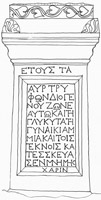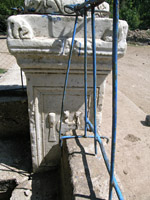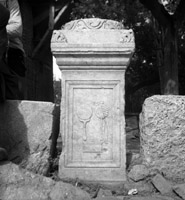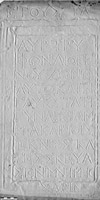 MAMA XI 121 (Akmoneia)
MAMA XI 121 (Akmoneia) 
Funerary bomos of Aur. Tryphon and family
- Type of monument:
- Funerary bomos.
- Location:
- Ahat (Akmoneia): outside a mosque by the river, below the acropolis.
- Description:
- Marble bomos with omphaloid top; broken above, buried below. On omphalos, ivy-scroll relief decoration. Front panel: inscription. Right panel: large mallet and two bevelers. Left panel: beveler, leather-knife and awl. Rear panel: mirror and spindle with distaff (above), comb (below).
- Dimensions:
- Ht. 1.10+; W. 0.50 (shaft 0.39); Th. 0.49 (shaft 0.38); front panel Ht. 0.44, W. 0.245; letters 0.027-0.050.
- Record:
- Squeeze (front face only); line drawing; MB notebook copy; photograph (rear face only) (1955/101); PJT photographs (2004: front and left faces).
- Publication:
- None.
- Date:
- AD 216/7 (Year 301 of Sullan era)
ἔτους τα´
Αὐρ(ήλιος) · Τρύ-
φων Διογέ-
νου ζῶν ἑ-
5αυτῷ καὶ τῇ
γλυκυτάτῃ
γυναικὶ Ἀμ-
μιᾳ καὶ τοῖς
10τέκνοις κα-
τεσσκεύα-
σεν μνήμης
vac. χάριν
Year 301. Aur(elius) Tryphon, son of Diogenes, constructed (the tomb) while still living for himself and his sweetest wife Ammia and his children, in memoriam.








This type of funerary monument (bomos with moulded panels on all four sides, with domestic objects depicted in relief on the lateral and rear faces) is highly characteristic of Akmoneia: Robert, Hellenica X, 247-56, and see also MAMA XI 123 (1955/93) and MAMA XI 124 (1956/42) (cf. MAMA XI 85 [1956/44]: territory of Sebaste). The mirror, spindle, distaff and comb depicted on the rear face of the monument are sufficiently similar in design and treatment to those depicted on the tombstone of Aur. Frugianus from Akmoneia (Robert, Hellenica X, 249-50, with Pl. XXXIII; compare Pl. XXXII and XXXIV) to suggest that the two tombstones were produced by the same workshop. The tools depicted on the left and right sides of the monument (a round knife, three bevelers, mallet and awl) suggest that Aurelius Tryphon was a leather-worker (σκυτότομος).
For the spelling of κατεσσκεύασεν with double sigma, compare e.g. MAMA VI 335a (Akmoneia); IGR IV 760 (Eumeneia); TAM V 2, 1384 (Magnesia under Sipylos).
The monument was still located in the village of Ahat, opposite a mosque beside the river, in September 2004.